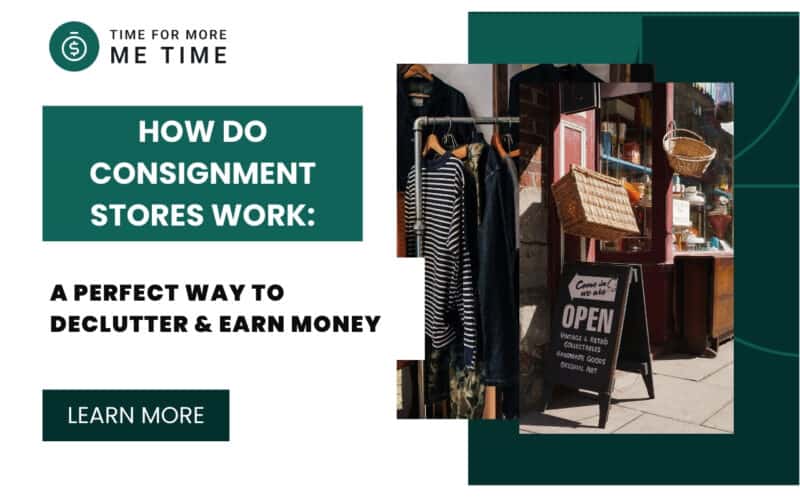Christmas is just around the corner, and like many of you, I’ve been digging through my storage room, trying to find the old Christmas lights. I found the tree, but what really caught my attention was the mess. Junk. Piles of stuff I’ve been holding onto without realizing it.
I have this habit of tossing anything I don’t use into the storage room—open the door, throw it in, and forget about it. It felt like a foolproof way to keep the house clutter-free.
Out of sight, out of mind, right? For the most part, it works. I rarely go in there unless I need something, like now, while hunting for Christmas decorations.
And maybe you’re in the same situation—digging through storage for the holiday essentials, only to stumble upon items you forgot existed.
In my case, I found unused furniture, clothes, and accessories stuffed into corners. It hit me hard. The clutter annoyed me, made my heart race, and raised my blood pressure. I couldn’t believe how much junk I’d accumulated.
It got me thinking—what better time to clear out the storage than now?
The holiday season feels like the perfect moment for a fresh start. I decided that by the time the new year rolls in, the only things left in that storage room will be the Christmas decorations I plan to use next year.
With that goal in mind, I decided to turn my unused items into extra cash. The solution? Consignment shops.
The last time I worked with a consignment shop was years ago. I made a couple of hundred bucks, which felt like a win. Not only was my clutter gone, but I also walked away with some extra money. It was a neat solution.
So instead of letting your unused items sit and gather dust, why not give consignment shops a try? With a little effort, you can take your items to a shop nearby and let them do the work for you. And if you have time to spend, you can also think of the best business ideas for you to fully utilize consignment stores.
While consignment shops are fairly common, I’ve realized many people aren’t familiar with how they work. That’s why, in this post, I’ll walk you through what they are and how you can benefit from them.
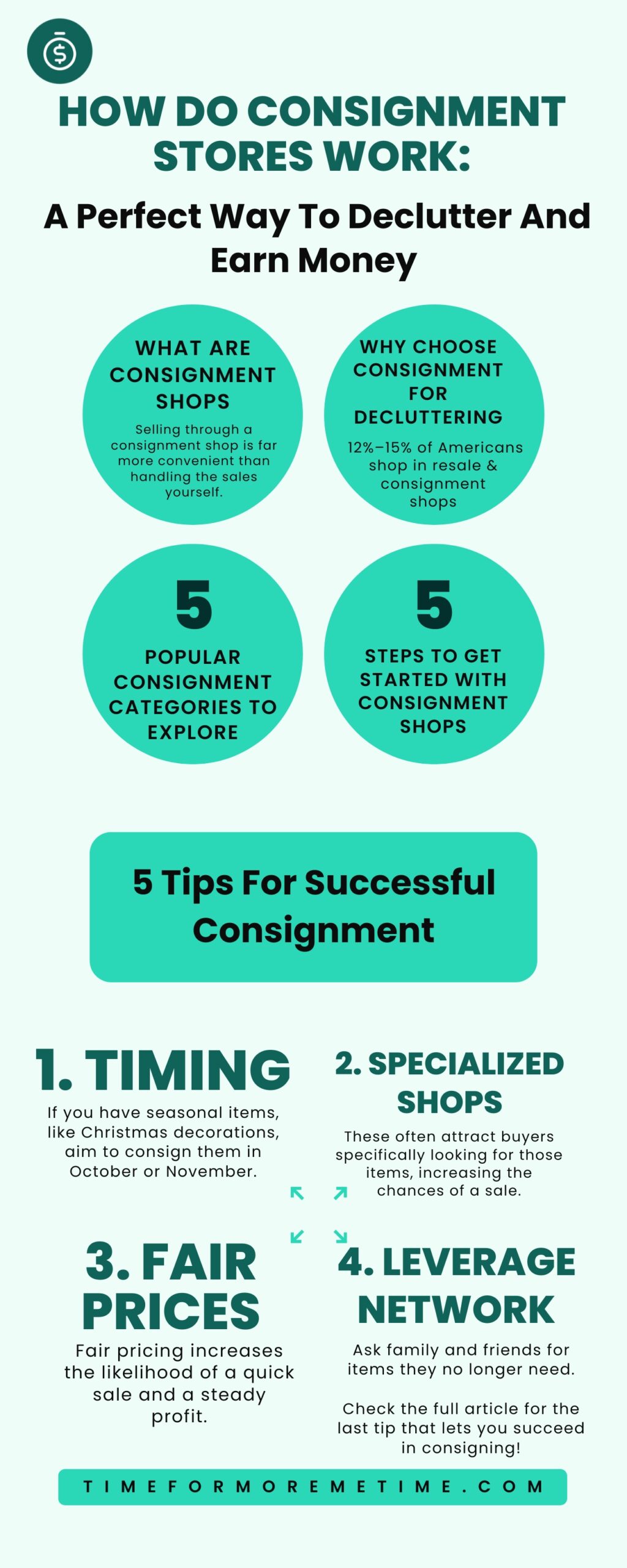
What Are Consignment Shops
Consignment shops are stores where you can sell your gently used items. It’s that simple. However, take note of the key phrase: gently used. These shops typically only accept items that are in near-pristine condition.
While some may accept slightly worn or older items, they usually need to be of high value to qualify.
Unlike pawn shops, consignment shops don’t buy your items outright. Instead, they take your items—if they meet their criteria—display them in their store, or list them online for sale.
This system works on a profit-sharing model. When your item sells, the shop takes a percentage of the profit, and you receive the rest.
It’s a fair deal when you think about it. Selling through a consignment shop is far more convenient than handling the sales yourself and trying to find trending eBay products you have in store to sell.
Imagine the time and effort it would take to advertise your items, showcase them to potential buyers, deal with haggling, determine prices, and manage customer service.
By letting a consignment shop do all the work, you save time and energy while still making money from your unused belongings.
Why Choose Consignment For Decluttering
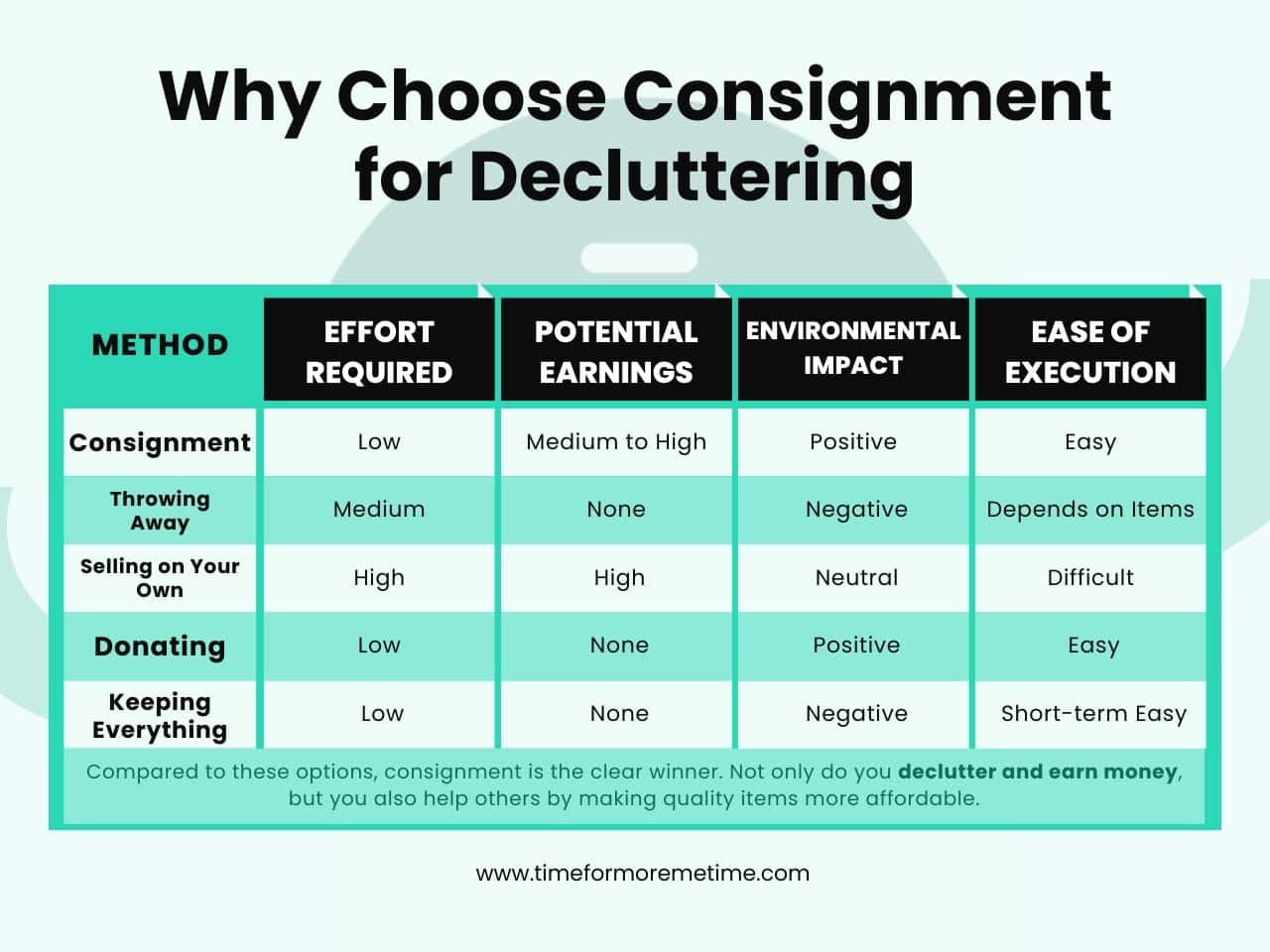
Why consignment? It’s simple. Consignment shops handle the hard part for you. Once you hand over your items, you can sit back and wait. If something sells, you get paid—it’s that straightforward.
And here’s a fun fact: almost 12%–15% of Americans shop in resale and consignment shops. That’s a lot of people and increases the chances of your stuff being sold! Anyway, back to the point.
Now, you might think about other ways to deal with your clutter. Throwing things away might seem easy, but it can be more trouble than it’s worth. If you have a lot to get rid of, you might need to rent a truck, which costs extra.
Plus, local rules often make it tricky to dispose of large items like furniture. And let’s be honest—adding to the landfill doesn’t feel great when we’re already dealing with so much waste.
As a side note, the average American gets rid of 68 pounds of old clothes every year. That’s a lot, and just imagine how much of it ends up in landfills.
Selling your items yourself could be another option, but it takes a lot of effort. Organizing a garage sale, advertising online, dealing with buyers, setting prices, and negotiating can quickly turn into a full-time job. Not everyone has the time or patience for that, especially during the busy holiday season.
Donating is a kind-hearted choice, and there’s no real downside—except you won’t make any money. If you’re already feeling the pinch with holiday expenses, donating might not be ideal.
Of course, you could choose to reorganize and keep everything.
But does holding onto unused stuff actually help? Be honest—are you just turning into a hoarder? On a serious note, 2.6% of Americans are actual hoarders.
If you think you are, I recommend getting checked by a professional, as hoarding can be a very debilitating mental condition, especially when it comes to a person’s social life.
Compared to these options, learning how do consignment stores work is the clear winner. Not only do you declutter and earn money, but you also help others by making quality items more affordable. It’s a win-win for everyone.
What Are Popular Consignment Categories To Explore
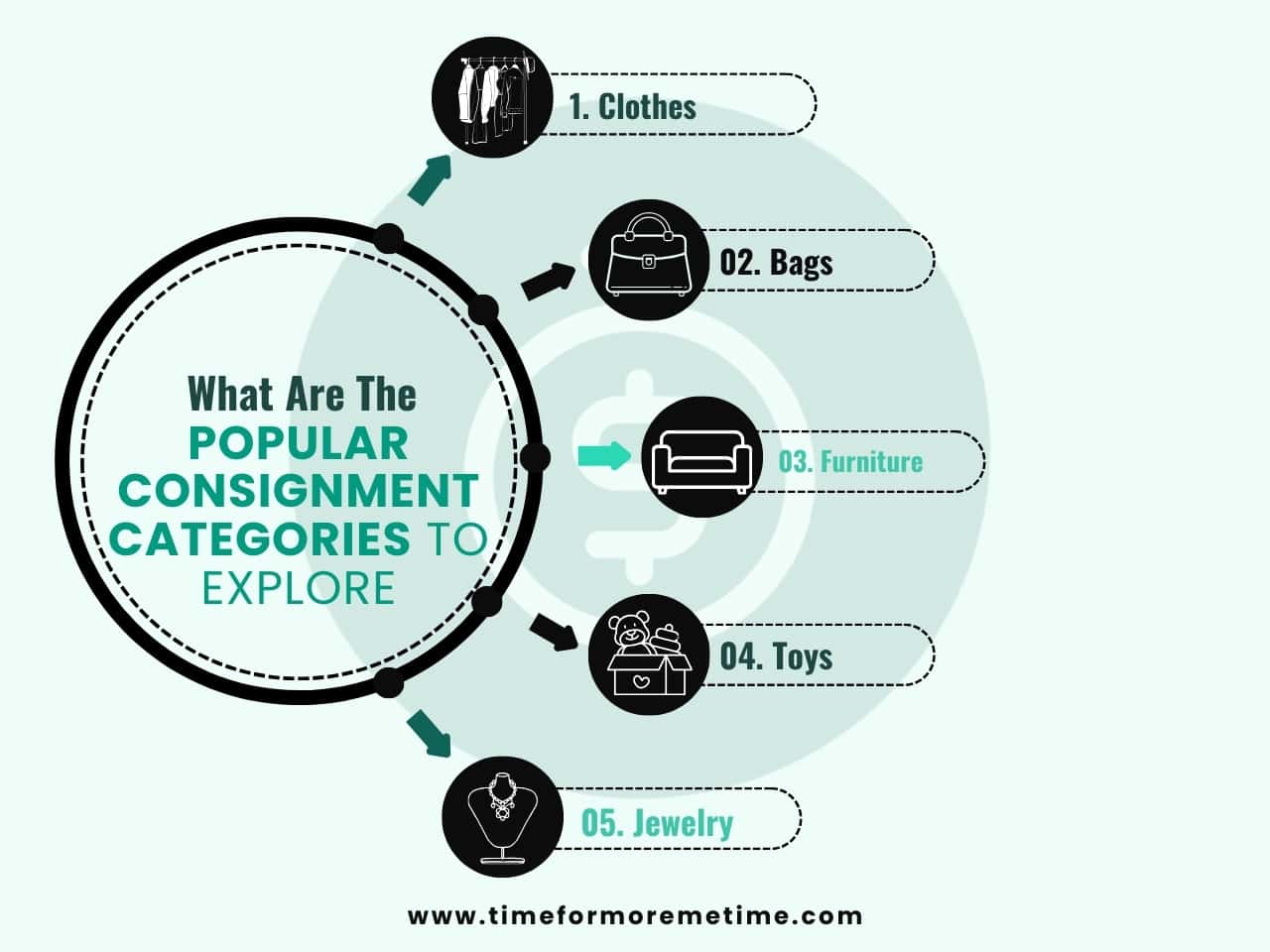
Keep in mind, consignment shops don’t take everything. If they did, these shops would be packed with junk, and shoppers wouldn’t find what they truly need or want.
So, how can you tell if your items are likely to be accepted? Here are a few categories to focus on:
- Clothes: Clothing is always a top seller at consignment shops. Special occasion items like wedding gowns, suits, and coats are especially popular. Children’s clothes also do well since kids outgrow them quickly. Trendy and fashionable clothes are more appealing to buyers, and branded pieces tend to sell even faster. Do you know that one in three clothes that Americans buy are second hand? That’s how good clothes are for consignments!
- Bags: Bags are a hot item in consignment shops. While I may not fully understand the fascination, they’re undeniably popular. For many, bags are like cars—they’re a status symbol and a personal favorite. Designer bags, in particular, are highly sought after, making them perfect for consignment. And let’s face it, most of us don’t use all the bags we own, so why not pass them on?
- Furniture: Furniture is another favorite at consignment shops. There’s always someone looking for pieces to update their home. To make your furniture more appealing, ensure it’s in good condition. Sets like dining tables with chairs or sofa sets with matching coffee tables tend to sell better.
- Toys: Toys are consistent bestsellers, especially since kids quickly outgrow them. They’re often passed from one family to the next through consignment shops, creating a cycle of reuse. Instead of letting old toys collect dust, consign them and let another family enjoy them.
- Jewelry: Jewelry, especially quality pieces like gold, silver, or gemstones, is another category worth considering. From vintage necklaces to trendy bracelets, jewelry appeals to a wide range of buyers looking for something special at a fraction of the retail price. Even costume jewelry can find a home as long as it’s stylish and in good condition.
Surely, your items may fit into at least two of these categories. If they don’t, you might want to try your luck at a general consignment shop and hope they can take most of your items.
How To Get Started With Consignment Shops
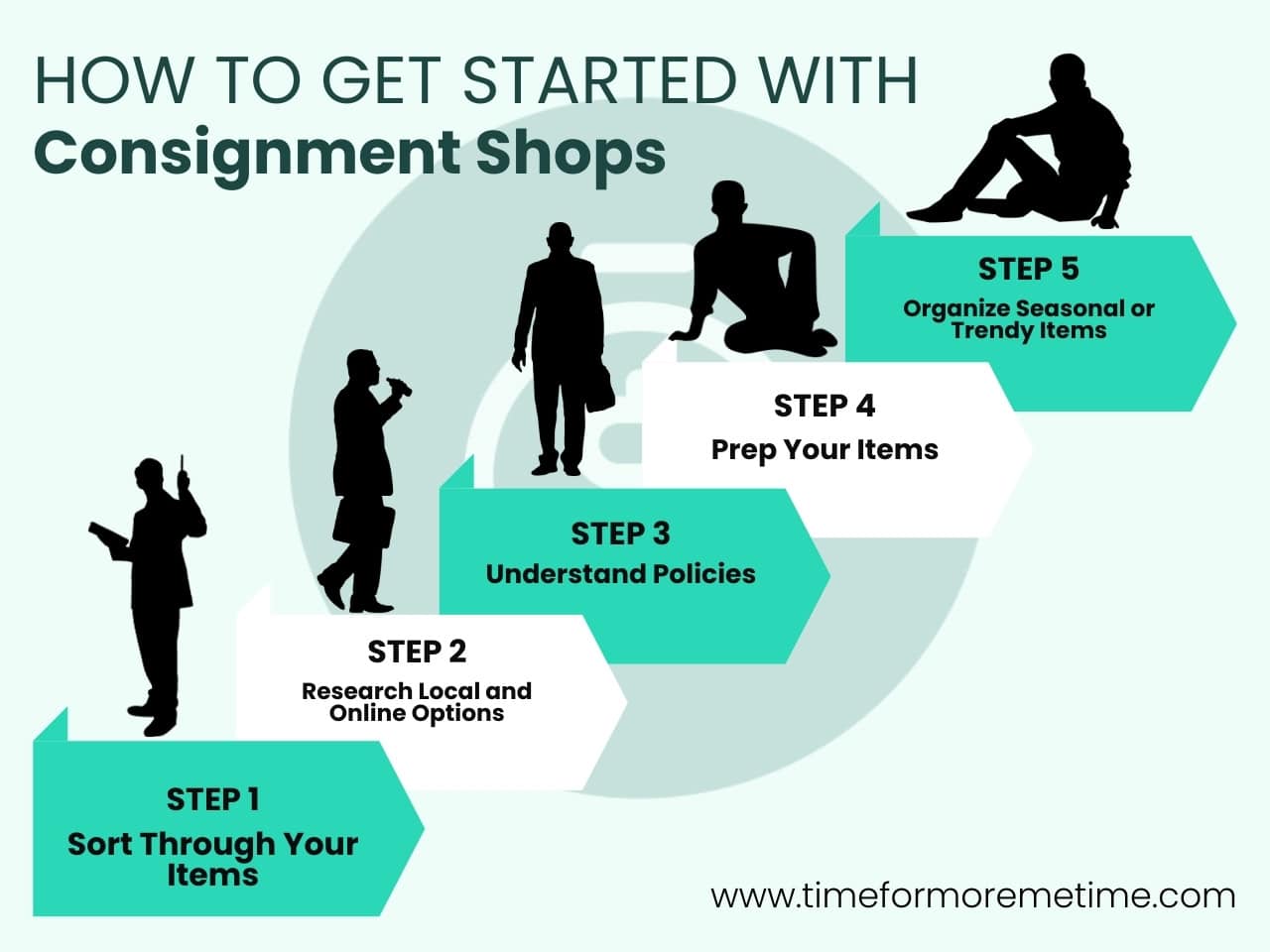
Thinking about using consignment shops to declutter? You should! With us acquiring twice as many material goods compared to half a century ago, I’m sure you have a lot to consign as well.
To get started with consignment shops, follow these steps to make the most of it:
- Sort Through Your Items: Start by separating your damaged or worn-out items from the rest. Recycle or dispose of these responsibly—unless they hold some inherent value, like a rare first-edition comic or vintage collectible. Even if damaged, such items might still be worth consigning.
- Research Local and Online Options: Find consignment shops that match the type of items you’re selling. Some shops accept a bit of everything, while others specialize in specific categories like furniture, clothes, or luxury goods. Start with specialized shops, as they’re more likely to offer better results, and then move on to general stores if needed.
- Understand Policies: While most consignment shops pay you after an item sells, some offer upfront payment. Keep in mind, upfront payouts are usually lower than what you’d earn post-sale. If you’re exploring online consignment, be sure to review their specific terms, as they may differ from brick-and-mortar stores.
- Prep Your Items: Clean, iron, and make minor repairs to ensure your items look appealing. Be careful not to cause more damage in the process. If you’re unsure how to fix something, tutorials on platforms like YouTube can help you repair or refurbish your items effectively.
- Organize Seasonal or Trendy Items: Timing is everything. Shops tend to sell seasonal items, like winter coats or holiday decorations, more quickly during their respective seasons. Similarly, trendy or in-demand items are more likely to catch a buyer’s eye, so prioritize consigning those first.
These are just the basics, but there are plenty of ways to go the extra mile to maximize your success with consignment shops.
One option is to ask friends and family for recommendations on shops they trust or have had good experiences with. They might know of hidden gems in your area that offer great deals or are more selective, which could work in your favor.
Personal referrals can also help you build a relationship with a shop, potentially leading to better deals or more favorable terms.
Additionally, some consignment shops offer promotions or sales events during certain times of the year, so keeping an eye on these opportunities can help you get your items in front of a larger audience.
You could also inquire about any specific seasonal needs they may have—for example, a shop may be looking for winter coats or holiday décor just before the season kicks in.
What Are Some Tips For Successful Consignment
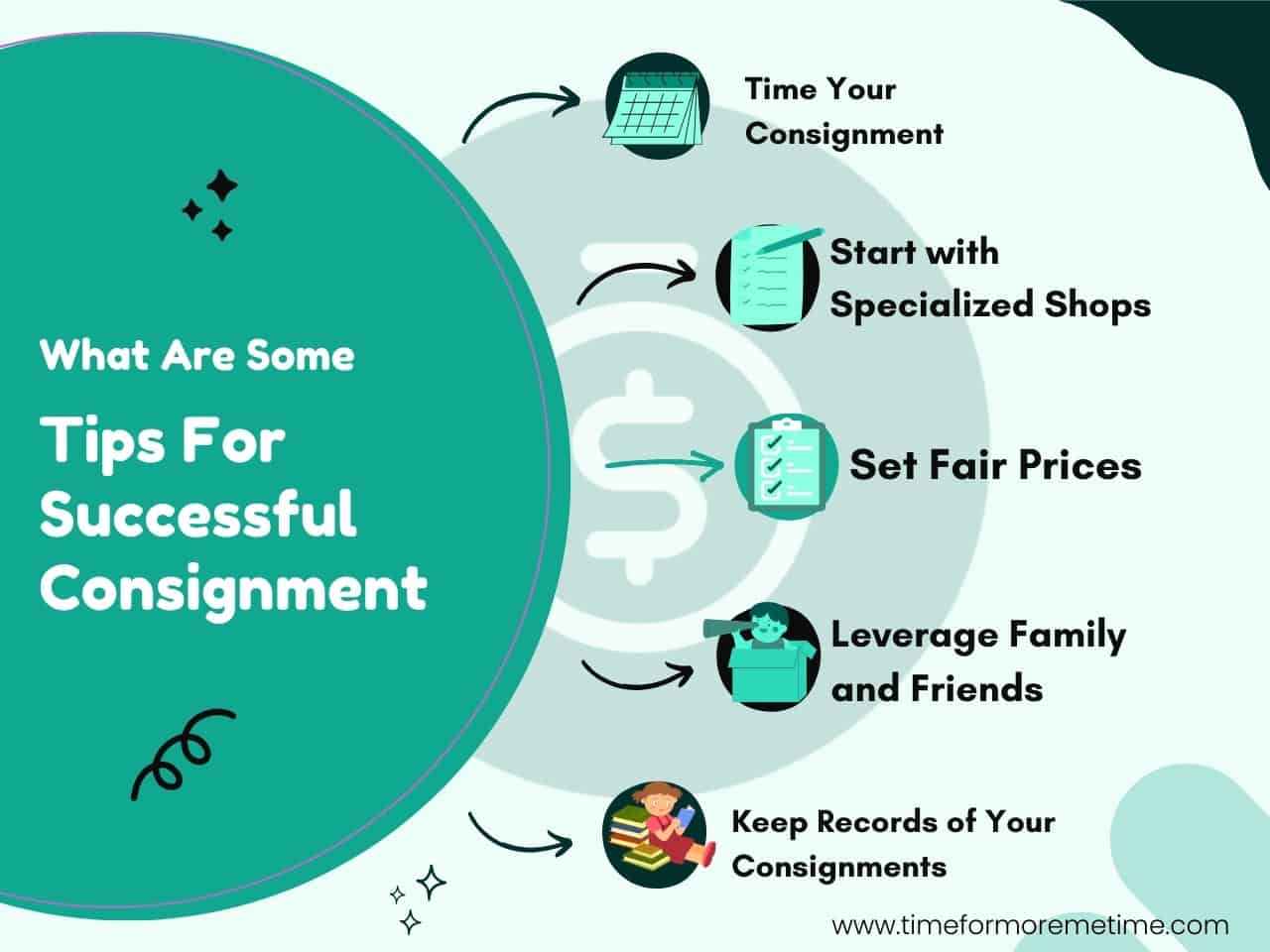
Now that the basics are out of the way, here are some practical tips I’ve learned from consigning my own items. While I didn’t have a ton to sell, I managed to process everything efficiently and make a decent profit:
- Time Your Consignment: Timing matters. If you have seasonal items, like Christmas decorations, aim to consign them in October or November. Seasonal items are more likely to sell quickly when demand is high, making it easier to turn a profit.
- Start with Specialized Shops: As mentioned earlier, prioritize specialized consignment shops. For instance, if you’re selling bags, take them to a shop that focuses on accessories instead of a general store. Specialized shops often attract buyers specifically looking for those items, increasing the chances of a sale.
- Set Fair Prices: Some consignment shops will have a set pricing structure, but others may ask for your input. Be realistic with your pricing—don’t overvalue your items. Fair pricing increases the likelihood of a quick sale and a steady profit.
- Leverage Family and Friends: If you don’t have much to consign but want to maximize your effort, ask family and friends for items they no longer need. Let them know you’ll handle all the work in exchange for a small percentage of the profits. It’s a win-win for both sides.
- Keep Records of Your Consignments: Track what you’ve consigned, where you’ve taken it, and the expected return. This helps you stay organized and ensures you don’t lose track of items, especially if you’re working with multiple shops.
While these may not guarantee instant success, they can definitely increase your chances of selling your items for a good price. Be sure to keep a receipt for any items you consign. It helps verify authenticity and can even influence the selling price.
FAQs
Before we wrap up, here are some important details I didn’t cover earlier:
How do consignment shops determine the price of my items?
Consignment shops determine the price of your items based on a variety of factors, including the item’s brand, condition, age, demand, and current market trends.
They may have their own pricing guidelines or policies, but often, they use their experience and knowledge of the market to set a fair price.
If you’re given the option to suggest a price, it’s important to be realistic and consider the item’s original value, its condition, and what similar items are selling for in the shop.
Can I consign items that I’ve previously bought from a thrift shop or flea market?
Yes, you can consign items you’ve previously bought from a thrift shop or flea market as long as they meet the consignment shop’s quality standards. Items that are gently used, in good condition, and still have value are typically accepted.
However, keep in mind that consignment shops may be less inclined to accept items that are too worn or out of style, even if they come from a thrift shop or flea market.
It’s always a good idea to check with the shop to ensure the items meet their criteria.
What happens if my item doesn’t sell?
If your item doesn’t sell within the agreed-upon timeframe, the consignment shop will usually return it to you, though some shops may donate or dispose of unsold items if you don’t pick them up.
The length of time before an item is returned can vary depending on the shop’s policies, but typically, unsold items are either marked down, returned to the consignor, or donated to charity.
It’s important to clarify the shop’s policy when consigning your items so you know what to expect if your item doesn’t sell. And if they don’t sell, you may want to look for other avenues and think of side business ideas that you can utilize to get rid of your items.
Conclusion
There you have it—understanding how do consignment stores work! It’s time to get rid of the junk and free ourselves from the hold of being a hoarder. And the best way to do that is by sending your unused items to consignment shops.
As you’ve seen, it’s an efficient way to declutter and make some extra money.
Hopefully, you’ll earn a nice little chunk of cash—it could come in handy for the Christmas celebrations, right? Anyway, good luck, and have a merry Christmas!
Don’t forget to subscribe to our YouTube channel @timeformoremetime to be updated on finance-related and time-saving tips! Or check our articles if you want to know more about the benefits of decluttering!
